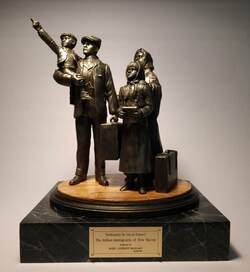City progresses towards replacing Wooster Square monument
The Wooster Square Monument Committee is working to approve a replacement statue amid contention over the legacy of Christopher Columbus.

Courtesy of Bill Iovanne Jr.
As New Haven celebrated both Indigenous Peoples Day and Italian Heritage Day last week, Elm City officials and community members made progress towards approving a new Wooster Square monument to replace the previous statue of Christopher Columbus.
The former Wooster Square monument depicting Columbus was removed in June 2020, following years of community organizing and a nationwide debate about the public place of colonial statues. In order to select a monument that would appropriately honor the relationship between Italian Americans and the City of New Haven, New Haven Mayor Justin Elicker formed the Wooster Square Monument Committee. In July 2021, the committee selected New Haven artist Marc-Anthony Massaro’s monument proposal from a pool of six finalists. Currently, the Committee is fundraising for the new monument, as it will be privately funded, as well as securing approvals from boards and commissions throughout the city of New Haven.
Titled “Indicando la via al futuro,” which translates to “Pointing the way to the future,” Massaro’s monument will depict an Italian family during the 19th-century wave of Italian immigration to the United States. Wooster Square Monument Committee co-chair Bill Iovanne Jr. said the monument will sit on the same pedestal as the Columbus statue, but four new storyboards depicting different scenes of Italian immigration to and in New Haven will surround the pedestal in its garden setting.
Initially constructed in 1892 to commemorate the 400th anniversary of Columbus’ voyage to the Americas, the Columbus statue was funded by the sizable Italian American community in the Wooster Square neighborhood. Many Italian Americans considered Christopher Columbus to be a cultural figurehead and a tie between their community and the founding of America, according to some commentators.
Community members and activist groups such as New Haven-based Unidad Latina en Acción, however, have questioned this framing of history and demanded change. John Lugo, an activist with Unidad Latina en Acción, hoped that Columbus Academy, a local New Haven school named for Christopher Columbus, would change its name to commemorate an Indigenous person.
In July 2020, Lugo told the News that “there’s a historic debt towards those who were here before [Columbus],” referring to the Quinnipiac and other Indigeneous peoples who occupied the Americas before the arrival of Columbus.
Norm Clement, a member of the Penobscot Nation, attended a June 2020 protest for the removal of the Wooster Square Columbus statue.
“We’ve been fighting for this for years, not only here but across the country,” he said, according to reporting from The Arts Paper of New Haven. “[The monument of] Columbus only represents to us murder, rape, and massacre, the enslavement of Indigenous people and the continued genocide that we have endured for over 500 years.”
In an article published by The Arts Paper, Massaro said that he wanted to depict a family rather than a single famous person in his new monument. In a Zoom meeting, Massaro explained that individuals are imperfect, and choosing to depict another prominent figure could lead to renewed controversy.
Iovanne wrote in an email to the News that the reaction to the new monument has been “overwhelmingly positive.” He noted that the project is expected to be finished in the next 18-24 months.
Dan Onofrio, who was president of the Connecticut Grand Lodge of the Order of Sons and Daughters of Italy in America during the Columbus statue’s removal and is a member of the Wooster Square Monument Committee, said that some of the Italian American community’s concerns still exist.
“I think the new monument is beautiful,” Onofrio said. “Is it something that resolves the issues we have around Columbus? I don’t know. I think that remains to be seen.”
One of the concerns Onofrio mentioned was finding a “potential new home” for the monument. He said it would be a “slap in the face” to the Italian American community if the statue was permanently kept out of public view.
Onofrio also expressed concern about ignoring Columbus’ role in history. He said that many Italian Americans see Columbus as a positive symbol for immigration. Former Sterling Professor of History Edmund Morgan, however, wrote in a 2009 Smithsonian article that Columbus’ main goal was to “take possession and to establish dominion.” Morgan cited correspondence between Columbus and the king and queen of Spain, in which Columbus describes the Arawak and Carib Indigenous people as “fitted to be ruled and to be set to work.”
According to Evan Roberts ’23, president of the Association of Native Americans at Yale and a Peer Liaison for the Native American Cultural Center, while removing the Columbus statue was a “huge step” for the city, New Haven officials should have done more to honor the work of Indigenous and Black organizers.
“My hope was that in the place of that monument there would be a statue commemorating the history of Black and Indigenous people on this land,” Roberts wrote. “I think both Black and Indigenous peoples’ need to be recognized more in this area as part of the region’s history, and it was because of Black Lives Matter and other Black-led movements of protest in New Haven that this statue was removed in the first place.”
Wooster Square became a local historic district on June 11, 1970.








